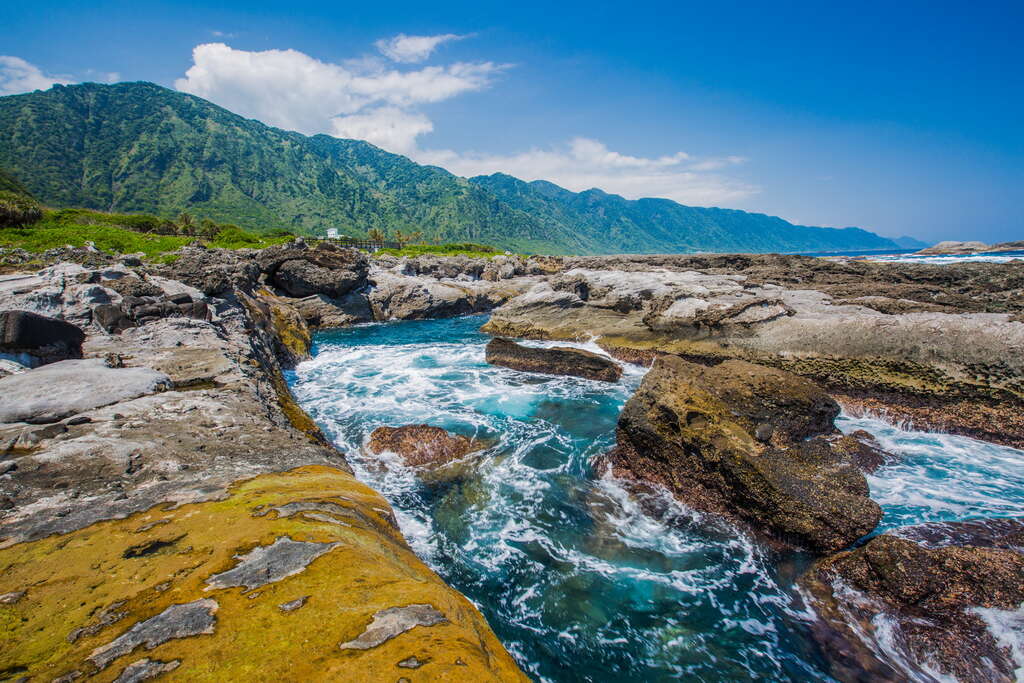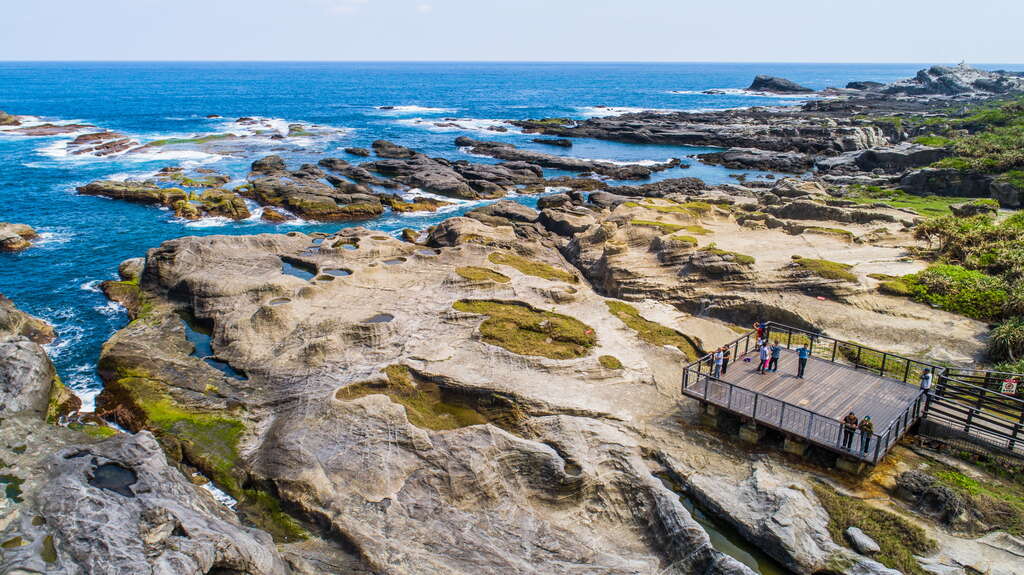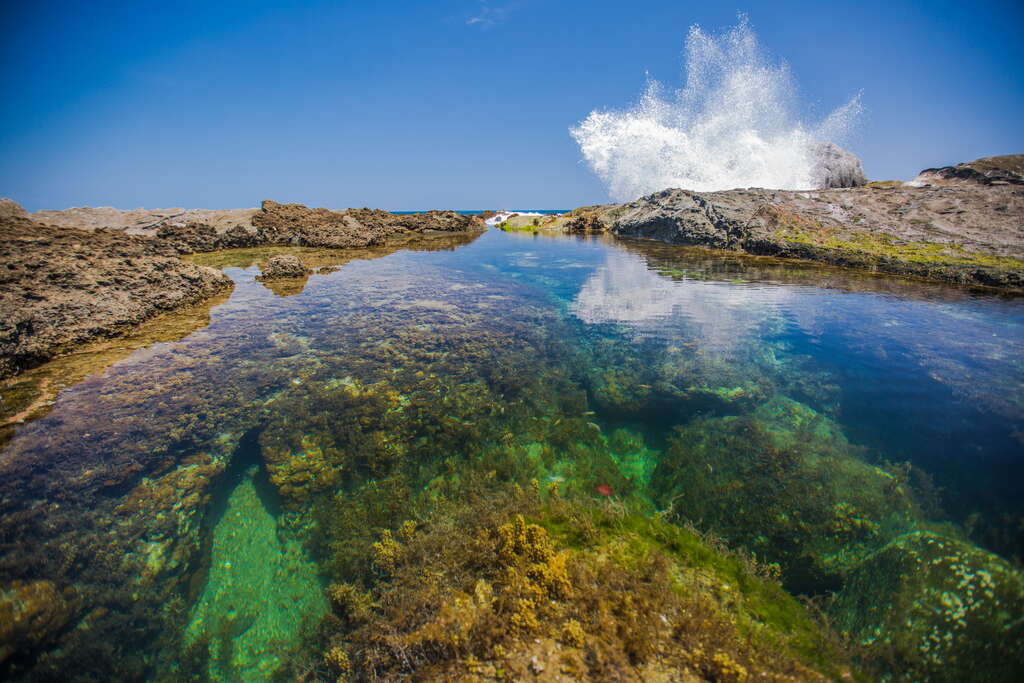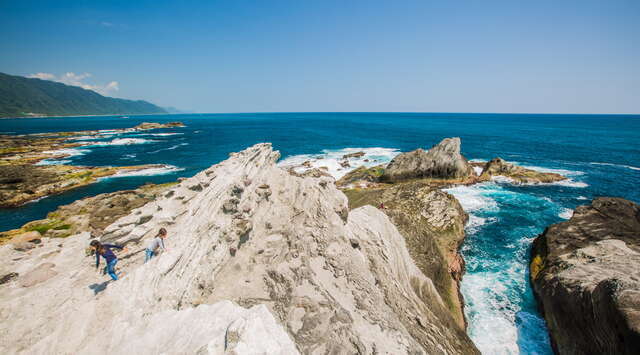Shitiping
Updated:2024-11-25
Popularity
64195Fun activities
- Abundant coral reefs and tropical fish
- The sea-eroded pothole landscape is the best in Taiwan
- Suitable for observing intertidal zone ecology, diving, and rock fishing
- Camp here, listen to the waves, and fall asleep watching the stars
- Shitiping Port is a great place for whale watching in Hualien
- Shimen Cave, which is 5 kilometers away from Shitiping, was the filming location of the movie "Silence"
Feature
- History and CultureHistory and CultureThe Shitiping tribe [Tidaan] is formed by part of the Makotaay tribes who migrated here, mainly the Amis, followed by Han Chinese. The main language is first Amis, second Chinese. The rituals, music, dance, and lifestyle are similar to the Makotaay tribe 2 kilometers away. The fishing festival in mid-June and the harvest festival in late July are the main activities in this area.
In order to prevent the loss of craftsmanship of the ancestors, Shitiping tribes established a craft workshop. In addition, there are the passing down of wizard dance, traditional simple diet, and wine brewing. The tribes have spared no effort in the succession of traditional culture. - Nature and EcologyNature and EcologyShitiping has Hualien's only reef coastal forest, where many special species in Hualien are preserved, such as Coleus formosanus Hayata, which only grows in Taiwan and Malaysia in the world, and in Taiwan only grows in Lanyu and on the shore between Shitiping and Xinshe.
Among the coastal flora, the most common are screw pines, coast hibiscus, and sea lettuce. They are all humidity and salt resistant, and are excellent wind-proof and sand-fixing plants. In addition, the Taiwanese date growing on gravel is a precious species dating back to the ice age.
There are many round holes on the raised coral reefs that can be seen everywhere along the coast, where crabs and tropical fish dwell and swim. In the intertidal zone on the south coast, there are more diverse and abundant wildlife. Indigenous people can often be seen here collecting sea urchins, snails, and seaweed. - The CuestaThe CuestaWhen entering Shitiping, you will notice on the southeast corner of the coast, a hill of pale white to white color. This hill has a gentle slope on the inland side, and a steep slope on the seaside. This type of landscape with two slopes of different angles is called a "cuesta." Small cuestas can be commonly seen in the Shitiping area.
The slope on the west side of the cuesta has been eroded by sea waves and turned into a natural stone ladder. It is refreshing to climb up the ladder and look over the ocean! - Natural Sea Arches and Trenches.Natural Sea Arches and Trenches.Natural sea arches are usually formed on protruding headlands dues to the particularly strong sea erosion. After millions of years of carving by the waves, the cave body was eventually penetrated, and a gate was formed. It also looks like a bridge and so is called a sea arch.
In Shitiping, you can see many narrow trenches perpendicular to the coastline. These trenches concaving into the coast are formed by sea erosion and therefore are called sea trenches. On the north side of the cuesta, there is a sea trench stretching from east to west, the bottom of which has been eroded by waves and become very wide, but on the surface there is only a narrow slit. Whenever a large wave hits, sea water rushes in and gushes out of the slit. The compressed detonating sound with the visual of the sea water fountain is quite a spectacular scene. - PotholesPotholesHead east from the sea arch, you can see Shitiping's most famous cluster of potholes. Some potholes are away from the sea, and some are still being washed and carved by the waves.
The precious thing about the potholes in Shitiping is that they were formed on top of the mushroom-shaped stone!
At low tide, you can see three deep potholes on the wave-cut bench in the northeast corner. There are more than ten kinds of reef-building corals and various algae, fish, and invertebrates in the potholes.
The potholes entail the history of sea-eroded terrain and they may disappear at any time. The formed potholes away from the sea can also disappear due to weathering. The natural landscape at Shitiping is worth a trip. - The intertidal zoneThe intertidal zoneWalking down the trail next to Shitiping Workstation, you will reach a vast intertidal zone. At noon a few days before or after the first or the fifteenth of the lunar calendar, when the tide is low, it is the best time to observe the wildlife in the intertidal zone. In spring and summer, when you visit the intertidal zone, you can see a large green area, like a pasture in the ocean, providing a variety of algae as abundant food source for animals in the intertidal zone.
On the high tide line, the most unnoticeable but in large number are the winkles or periwinkles; and cone-shaped barnacles like small volcanoes. If the barnacles live on the third floor, then the residents on the second floor would be oysters. In the tidal creeks and crevices, the most common are brittle stars.
Around the low tide line, sea urchins and giant clams are often seen. Cowries are common animals. Chitons and blotched nerites can also be found on reefs. In addition, in the tide pools of the intertidal zone, many fish, shrimps, crabs, sea cucumbers, and shellfish can be found breeding here. - ShimenShimenHead north for 5 kilometers from Shitiping, you will arrive at Shimen.
From the rest stop, follow the granite trail in front of the viewing platform to Shimen Beach. It is a reef coast that stretches for several kilometers, named after a sea cave shaped like a gate on the beach. This sea cave has three openings to the outside world. The width of the cave is about 18 meters and the height is nearly 5 meters. There is a huge banyan tree growing on the sea cave, adding some fun features to the scene. On the south side of the sea cave, there is an igneous rock of peculiar color and with well-developed columnar joints. The whole rock appears to be composed of many hexagonal columns.
The coastline from Shimen Cave to the "Men Will Conquer Nature" monument has well-developed sea erosion landscapes such as sea trenches, sea caves, potholes and sea benches. The reef coast is a hotbed for all kinds of seaweed that becomes a feeding spot for fish and shrimp. Shimen is not only a popular rock fishing spot, but also a natural classroom for observing coastal wildlife. - Shiti PortShiti PortShiti Port is located to the northwest of Shitiping. It is the birthplace of, and also the best place for, whale watching in Taiwan. Your chances of spotting whales and dolphins would be the highest in Taiwan. There are more than 16 species of whales and dolphins in the open sea, among them four species are the most common, including pantropical spotted dolphins with a pointy rostrum and white spots, Fraser's dolphins who travel in groups, spinner dolphins that are like ballet dancers in the sea, and Risso's dolphins with a bulbous head. The chances of seeing whales and dolphins in one sail can be as high as 95%. April is the season of flying fish in the Hualien-Taitung sea. At this time, when you sail out to watch whales and dolphins, another big reward is to see the flying fish being chased and hunted by dolphins. Shiti Port has access to rich fish sources. In the fish market, you can find all the fresh catches of marlins, mahi-mahi, flying fish, and bonito brought back by the fishing boats. The busier auction times are 7:30am and 4:00pm. Affordable and high-value restaurants in the port area provide tourists with a delicious feast!
- Accessible facilitiesAccessible facilitiesAccessible facilities are available here. Please refer to the map.
Details
Shitiping has a special rocky shore landscape sculpted by wind and sea water erosion. The intertidal zone is rich in natural ecological resources: crabs, starfish, sea cucumbers, hermit crabs, and colorful fish, waiting for those with keen eyes to explore. At night, you can set up a camp at Shitiping camping ground on the marine bench. The next day, you can welcome the beautiful sunrise right in front of the tent, and watch the morning sun break through the clouds and cast on the sea, making it golden and brilliant.

World-class outdoor geology classroom
Shitiping is located at the south end of Shiti Bay in Fengbin Township, Hualien County. The entire area is a huge, well-developed sea erosion terrace. The marine bench, raised coral reefs, sea ditches, and sea cliffs can be easily spotted, among which the pothole landscape is the best in Taiwan.

The coast of Shitiping is rich in coral reefs and tropical fish. The tide pools formed by the potholes in the intertidal zone are filled with various marine life such as seaweed, fish, shrimps, and shellfish, making Shitiping the perfect place for observing intertidal zone ecology, diving, and rock fishing.

Visitors can follow the circular trail or climb up the 17-meter-high cuesta. You can enjoy the geological landscape of Shitiping as well as the magnificent view of the Pacific Ocean.

Ecological whale watching
Shitiping is a port full of vitality. Not only can you find fishing boats with their daily fresh catch here, this is also the birthplace of whale watching in Taiwan. Every summer, whales and dolphins always appear on the sea, attracting tourists to board the boats and capture their elegant form on camera. Why not get on a boat yourself for an ecological whale watching tour?
【Shitiping Camping Ground】
Tel: 0922-211336 Mr. Lu
Website: http://camping33.pgo.tw/

World-class outdoor geology classroom
Shitiping is located at the south end of Shiti Bay in Fengbin Township, Hualien County. The entire area is a huge, well-developed sea erosion terrace. The marine bench, raised coral reefs, sea ditches, and sea cliffs can be easily spotted, among which the pothole landscape is the best in Taiwan.

The coast of Shitiping is rich in coral reefs and tropical fish. The tide pools formed by the potholes in the intertidal zone are filled with various marine life such as seaweed, fish, shrimps, and shellfish, making Shitiping the perfect place for observing intertidal zone ecology, diving, and rock fishing.

Visitors can follow the circular trail or climb up the 17-meter-high cuesta. You can enjoy the geological landscape of Shitiping as well as the magnificent view of the Pacific Ocean.

Ecological whale watching
Shitiping is a port full of vitality. Not only can you find fishing boats with their daily fresh catch here, this is also the birthplace of whale watching in Taiwan. Every summer, whales and dolphins always appear on the sea, attracting tourists to board the boats and capture their elegant form on camera. Why not get on a boat yourself for an ecological whale watching tour?
【Shitiping Camping Ground】
Tel: 0922-211336 Mr. Lu
Website: http://camping33.pgo.tw/
Information
Open Time
/Always open.
Facilities
- Stay
- Parking lot
- View Point
- Bus station
- Trail
How to Get There
Choose a transportation method based on your departure location. 








